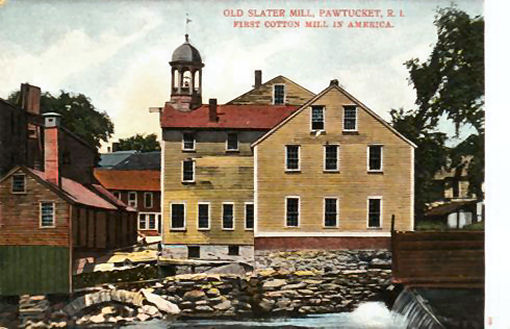![]()
Postal History Introduction
Stampless
Covers
1846
to 1900 Issues
1901-1950
Issues
1951-2003
Issues
Cancels
&
Miscellaneous
Postal
Stationery
Post
Cards
Air
Mail
First
Day &
Event Covers
Parcel Post/Special Delivery
Registered & Official Mail
Commercial & Advertising
Revenue & Postage Due
Wildlife & Game Issues
Complete List of RI Issues
|
Rhode Island Picture
Post Cards |
|
|
|
|
Samuel Slater was born on June 9, 1768 in Belpre, Derbyshire, Great Britain. He is known today as the "Father of the American Industrial Revolution." Slater gained a thorough knowledge of cotton manufacturing while serving as an apprentice in England to Jedediah Strutt and Richard Arkwright. He immigrated to the United States in 1789, attracted by the bounties offered there for workers that were skilled in the manufacturing of cotton. Slater was forced to keep his knowledge and skills a secret from authorities, however, because at the time emigration of textile workers and the export of drawings of textile machinery were forbidden by British law. In 1793 with his detailed knowledge of textile machinery and backing from the Rhode Island firm of Almy and Brown, Slater constructed his version of Arkwright's spinning and carding machinery in Pawtucket, RI. This was the first successful cotton mill in the United States. He subsequently established a number of other plants in New England and founded the town of Slatersville, R.I. Samuel
Slater died on April 21, 1835 in Webster, Massachusetts. THE MILL The original Slater Mill was built in 1793, it's dimensions were 29 feet by 42 feet. Constructed of wood, it resembled a period farmhouse and the long narrow shape of the building facilitated the transfer of power from the water wheel to the textile machinery. The basic design of the Slater Mill was repeated throughout Rhode Island and New England on later cotton mills. The Old Slater Mill is now used as a museum that showcases the history of textile manufacturing in America. There are 24 machines in the mill built between 1775 and 1922 which demonstrate the process of turning cotton into cloth. The Mill also includes a small movie theater and film history of the city of Pawtucket, Rhode Island. Slater and his brother established the town of Slatersville on the Branch River in North Smithfield, RI. The town included the Slatersville Mill; the largest mill in the country during that time. The town contained tenement houses for workers, the mill owner's home and a company store. INDUSTRIAL REVOLUTION Slater's cotton mills began the Industrial Revolution in America. This was a dramatic change in which machinery replaced hand tools, steam power replaced human power and unskilled workers replaced skilled workers. Another result of this revolution was that Cotton became the King of Southern Cash Crops leading to even harsher conditions and restrictions for African Americans. Slavery became even more institutionalized as way of life in the deep south where the Cotton Plantations depended on slave labor to harvest and get the crop to market. Another type of slavery became endemic in the North. The Slater Mill used child labor as did most textile mills of the time. The children ranged from 7 to 12 years of age and by 1830 over fifty-five percent of Rhode Island's mill workers were children. Their average wage was less than a dollar a week. |
![]()
RI Historical Society
The Post Offices
Home Page
RI Tercentenary Issue History
RI Philatelic Society
Recently Added Pages
Philatelic Primer
Rhode Island Around the World
Rhode Island
Town Postmarks
Other Websites of Interest
